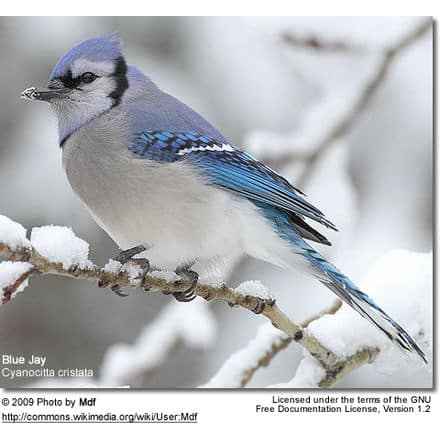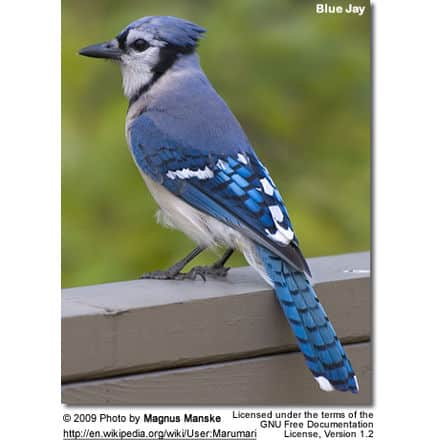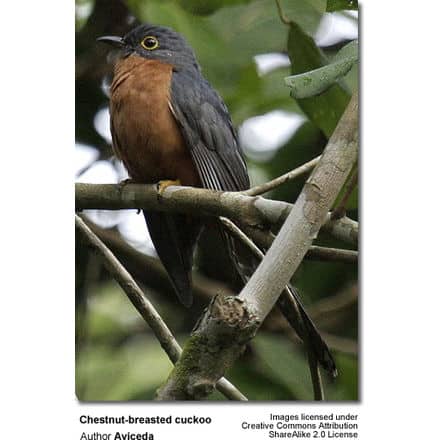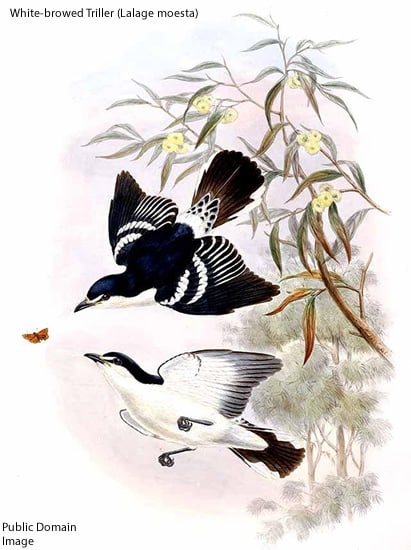Blue Jays (Cyanocitta cristata)
Blue Jays (Cyanocitta cristata) are beautiful crested, blue-plumaged, large songbirds that have an expansive distribution across North America.
These jays are generally unafraid of humans, and the availability of garden feeders and their willingness to exploit resources offered by humans have enabled these birds to expand their territories in the West.
Even though these birds are well appreciated for their colorful plumage details and confiding dispositions, they are amongst the noisiest of all birds and are known for their aggressiveness towards smaller birds visiting bird feeders.
Interesting Facts about Blue Jays
Distribution / Habitat
Blue Jays occur naturally in southern Canada (Newfoundland) and in the United States east of the Rocky Mountains. West of the Rockies, they are replaced by the closely related, darker-plumaged Steller’s Jays.
Northern populations may migrate south for the winter. Those found further south tend to be sedentary (non-migratory). The proportion of migratory Blue Jays is believed to be less than 20 percent.
Those birds that do migrate tend to do so in large flocks that often include thousands of them. Their migratory paths extend along the Great Lakes and the East Coast of North America. Migration takes place during the daytime.
They are quite common in mixed woodlands (especially those with oaks and beeches), and residential areas.

Subspecies and Ranges:
- Coastal Blue Jay or, simply, Blue Jay (Cyanocitta cristata cristata – Linnaeus, 1758) – Nominate form
- Range: Coastal southeastern United States from North Carolina south (except southern Florida) and east to Texas
- ID: Mid-sized jay. Vivid blue markings.
- Northern Blue Jay or, simply, Blue Jay (Cyanocitta cristata bromia – Oberholser, 1921)
- Range: Southern Canada (Alberta to Quebec) to northern USA.
- ID: The largest subspecies. Blue markings paler
- Western Blue Jay or Interior Blue Jay(Cyanocitta cristata cyanotephra – Sutton, 1935)
- Range: Southeastern Wyoming and Nebraska to western Kansas, Oklahoma and northern Texas
- ID: Mid-sized jay. Dark blue markings on the upper back and white below.
- Semple’s Blue Jay or Florida Blue Jay (Cyanocitta cristata semplei – Todd, 1928)
- Range: Southern Florida
- ID: The smallest subspecies
- [Florida Blue Jay (Cyanocitta cristata (florincola))] not universally recognized
Description
Size
- Large songbirds that are smaller than crows, but larger than robins
- Body length (including tail): 8.7 – 12.5 inches (22 to 32 cm)
- Wingspan: 13.4 – 16.9 inches (34–43 cm)
- Weight range: 2.3 – 3.84 oz (65 – 109 g)
Plumage Details / Adults
- Bright blue upper plumage
- Grey-blue head crest that can be raised or lowered
- White face with black markings
- Color on throat chest and abdomen range from white to grey
- Collar of black feathers across the lower throat and continuing around the head
- Blue and white patterned wings
- Blue, long tail with white and black bands
Other Physical Details
- Distinctive head crest
- Heavy black bill
- Black eyes, legs and feet
- Broad, rounded tail
Gender ID
- Males and females look alike, except males tend to be slightly larger than females
Juvenile Description
- Greyish plumage
- Wing and face patterns apparent in fledglings


Similar Species
- Western Scrub-Jay: No crest. Brownish-grey back. No white markings on the wings or tail. Blue cheeks and nape (back of the neck)
- Scrub-Jay: No crest. Solid blue wings and tail (no white barring).
- Steller’s Jay: Darker underparts. Less white in the wings. Black head and chest. Found in western North America; favors coniferous forests
Diet / Feeding
- Major food items:
- Plant material (~ 75% of the total diet): includes acorns (staple), beechnuts, seeds, wild fruits, berries, and grain. At bird feeders, they are fond of sunflower seeds and peanuts. Excess nuts or acorns may be stashed in holes in the ground.
- Animal Food: insects and their larvae, earthworms, spiders, snails, mice, and other small rodents and frogs. They also take small dead or injured animals (insects, mammals, or birds). Very rarely, they will destroy and eat the eggs and nestlings of smaller birds.
- Feeding / Foraging Behavior:
- Blue Jays store excess food for later use.
- Often drive other birds away from bird feeders
- Known to steal food from other birds
- Accept food items offered by people, including seeds from bird feeders (sunflower seeds), peanuts, bread, meats, chips, etc.
- Make their tools to reach food items that are otherwise inaccessible
Breeding / Nesting
Pair bond:
- Monogamous (bond for life or until one of the pair dies)
Breeding season:
- March through July
Breeding intervals:
- Northern parts of their range: one brood per year
- Southern parts of their range: up to two broods each year
Courtship Behavior:
- Aerial chases
- Male feeding female
Nest Placement and Construction:
- Nests are typically placed in trees or large bushes/shrubs, about 6 – 30 feet (~ 2 – 9 meters) above the ground
- Both the male and female construct the bulky, loose open cup nest out of twigs, sticks, grass, weeds, bark strips, and moss. The nest is sometimes strengthened with mud. Males and female both gather materials and build the nest, but on average male does more gathering and females do more building.
- The nest is lined with finer grasses, rootlets, and other materials found in their environment, such as pieces of paper, rags, feathers, down, and mammal hair
Egg Incubation / Raising of the Young:
- Clutch size: 2 – 7 eggs, but most of the time 4 – 6 eggs are laid
- Color of the eggs: pale blue, green, yellow, or buff; with grey or brownish spots
- Egg Size: Length: 1 – 1.3 in (2.5 – 3.3 cm); Width: 0.7 – 0.9 in (1.8–2.2 cm)
- Incubation period/duties: 16 – 18 days; mostly by females, but males may share in the incubation. The male provides food to the brooding female.
- Hatchlings are naked and blind, with red mouth lining.
- Feeding and protection of the chicks/nestlings: Both parents feed the chicks insects and other protein-rich food items. Both the male and female protect the young, chasing away intruders, and may mimic the calls of hawks or other birds of prey to scare off predators.
- Fledging time: 17 – 21 days after hatching
- Age of independence: 3 months
Calls / Vocalizations / Sounds
Varying calls include the distinctive “jay- jay” (for which they were named), as well as rattling sounds, growls, whistles, and chatters.
Alarm call: high-pitched layer-jayer call that increases in speed
Noise Level: Typically vocal, except when close to the nest site
A Young Blue Jay Mimicking the Call of a Red-tailed Hawk
Alternate (Global) Names
Chinese: ??? … Czech: Sojka chocholatá … Danish: Blå Skovskade … Dutch: Blauwe Gaai … German: Blauhäher … Finnish: Sinitöyhtönärhi … French: Geai bleu … Hungarian: kék szajkó … Italian: Ghiandaia azzurra americana … Japanese: aokakesu … Norwegian: Blåskrike …Polish: Modrosójka / Sójka b??kitna … Portuguese: Gaio-azul … Russian: ?????????????????? ??????? ????? … Slovak: Kapuciarka/ Sojka modrá … Spanish: Chara / Urraca Azul … Swedish: Blåskrika
Lifespan/Longevity
- Oldest recorded Blue Jay:
- in the wild (banded): 17 years and 6 months
- in captivity: 26 years and 3 months
- Average Lifespan in the Wild: 7 years
- Reproductive maturity: 1 year



